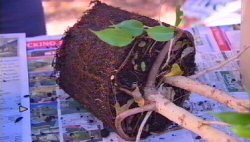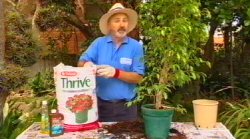|
When plants outgrow their pots you have two choices; you can pot them up into
a larger container thereby allowing the plant to keep growing or you can repot
them into the same container thereby keeping the plant about the same size it is
now.

 |
Potting up
Most people are familiar with this idea. You take a plant out of its present pot
and put it into a larger pot. Thatís the idea in a nutshell but for best results
itís not quite as simple as that. When plants have been in a pot for a while,
the roots will have grown congested and taken on the shape of the pot. If the
plant is just potted into a bigger pot, the roots wonít quickly spread into the
new potting mix Ė instead they will stay confined within the old rootball. That
original rootball can be much harder to wet than the fresh new potting mix which
surrounds it so the plant can go dry even though you are frequently watering it.
To avoid this, it is essential when potting up to tease at least the outer roots
out of the shape of the pot. A good tool to use for this is a dining fork with
the tops of its tines bent at 90į. Gently pull roots and some of the old potting
mix out right around the rootball. Remove any sodden soil from the base of the
root ball. If roots wind around the base, straighten them out and cut them off.
You can also cut off any large, long roots which you have loosened from the
sides. The end result will be a rootball which is smaller than it was and with
lots of roots dangling free. Any which are too long to be put back into the new
pot without bending should be trimmed.
Place new potting mix in the base of the new pot. Mound up the soil in the
middle so that if there is a depression in the base of the rootball, the mounded
soil will fill it. The top of the rootball should sit about 2cm below the rim of
the pot. Now fill in the gap around the sides with fresh potting mix. Use a
stick to press it down but donít over compact the potting mix. When finished,
tap the pot on the ground several times to settle the potting mix. Add more if
settlement occurs.
Water in well with a seaweed based plant tonic but do not feed with fertiliser.
Sit the plant in bright dappled shade and keep moist. Return to its original
spot after about two weeks.
 |
Repotting
Sometimes a plant is about the size you want it but still it has outgrown its
container. Signs of this will be roots forced to the surface or poking out
through the drain holes.
To keep a plant at the same size in the same sized pot you must reduce the size
of the rootball using the method above only this time you can be more drastic,
removing 3 - 5cm of soil right around the rootball and from its base. Trim any
overlong roots as outlined above and replace in the same pot which you have
scrubbed clean.
By removing a layer of soil and trimming the roots you will encourage finer,
fibrous roots to develop and grow into the fresh potting mix. The top growth can
also be lightly pruned if you wish but even without pruning the top growth
should remain about the same size with this treatment.
Water in well with seaweed solution and place in shade for a fortnight to
recover. Start feeding about six weeks later.
|